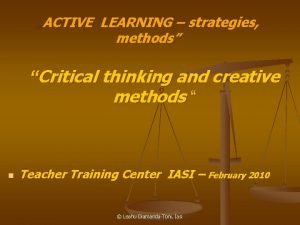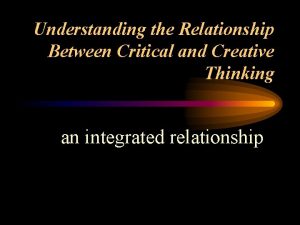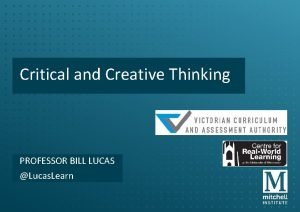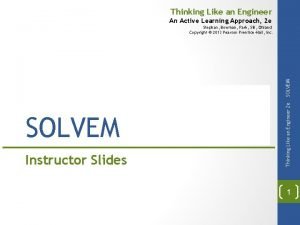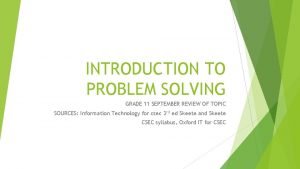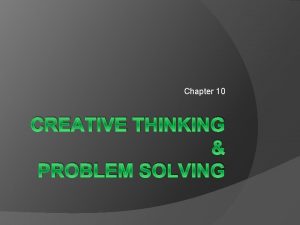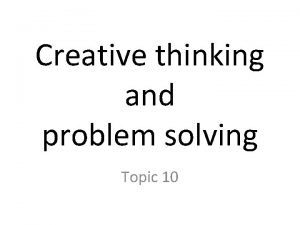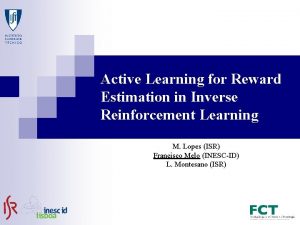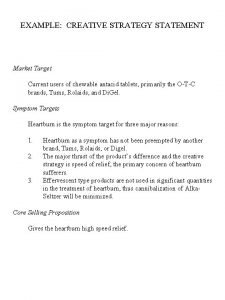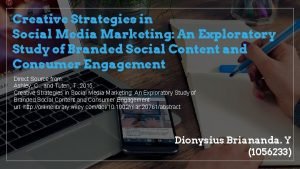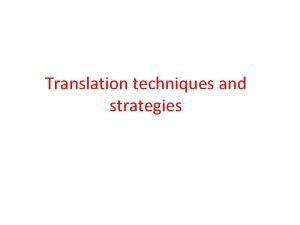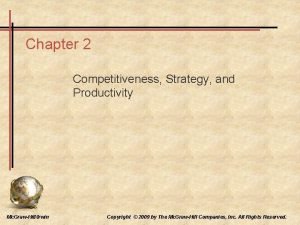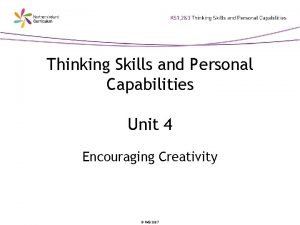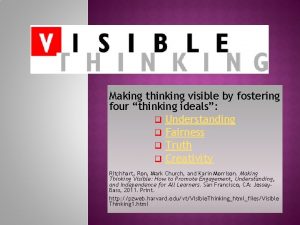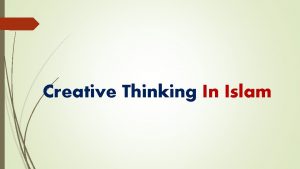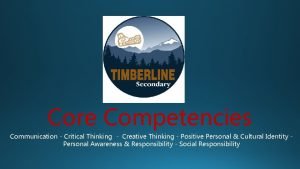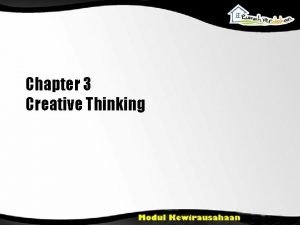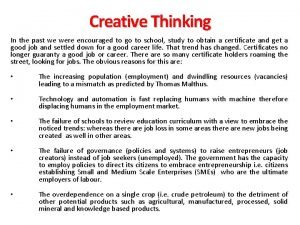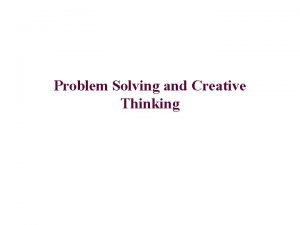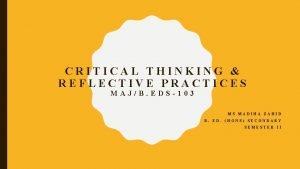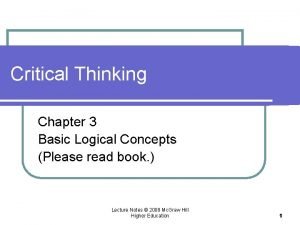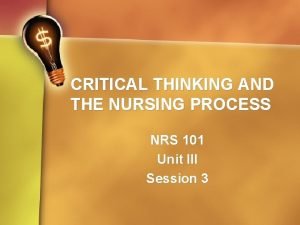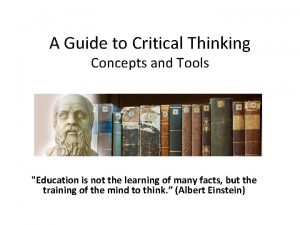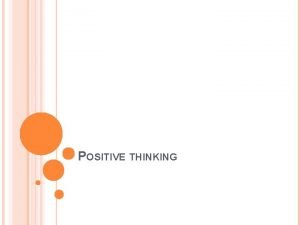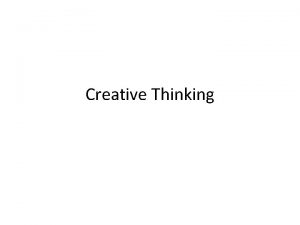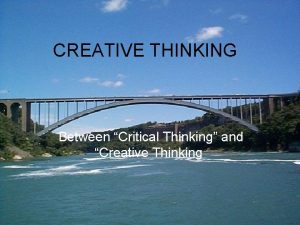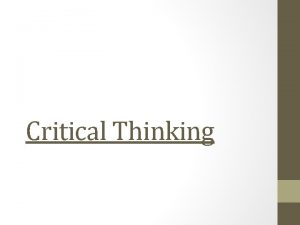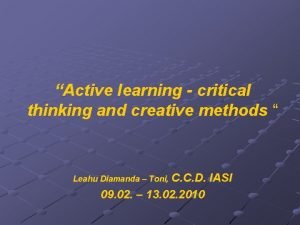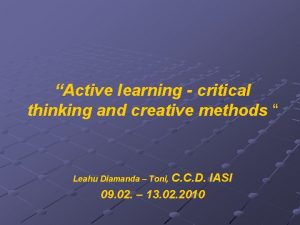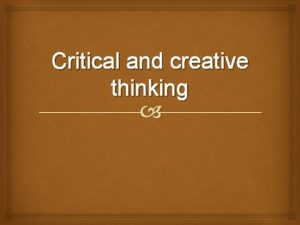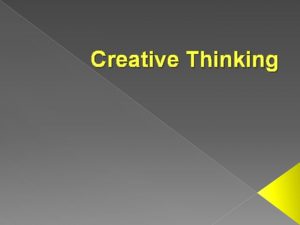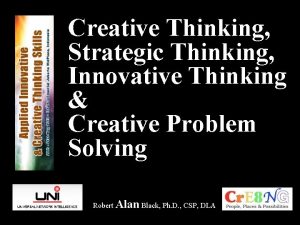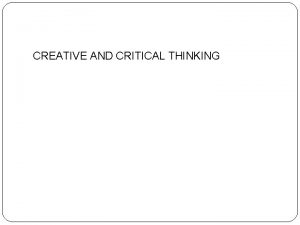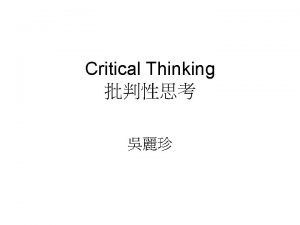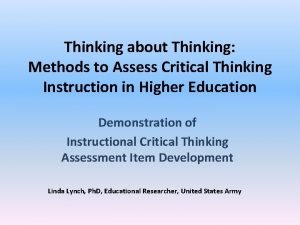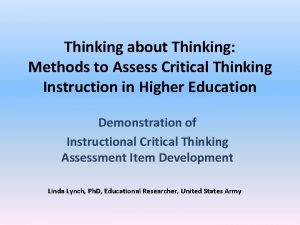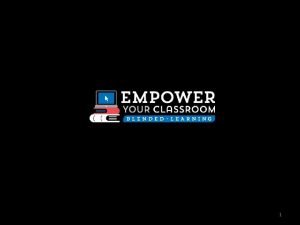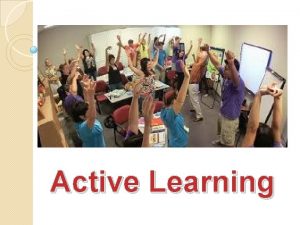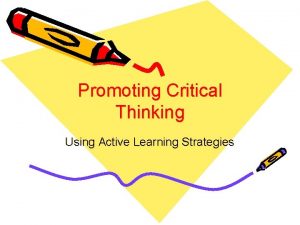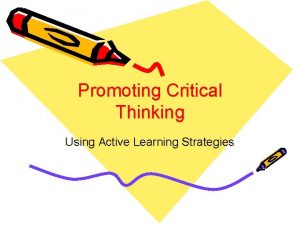ACTIVE LEARNING strategies methods Critical thinking and creative




































- Slides: 36

„ACTIVE LEARNING – strategies, methods” “Critical thinking and creative methods “ n Teacher Training Center IASI – February 2010 © Leahu Diamanda-Toni, Iasi

Methods for active learning I. n n n Methods that promote understanding of concepts and ideas, emphasize the students’ experience, develop communication, social, cognitive skills, and develop active attitudes: Discussion Debate Role play © Leahu Diamanda-Toni, Iasi

II. Methods that stimulate thinking and creativity, encourage students to search and to develop solutions for various problems, to make critical assessments, value judgments, to compare and analyze given situations: Ø Case study Ø Problem solving Ø Educational games Ø Exercise © Leahu Diamanda-Toni, Iasi

III. Methods through which students learn to work in a team in a productive manner and to develop their communication, collaboration skills: Ø Learning through cooperation Ø Alternative methods for critical and creative thinking © Leahu Diamanda-Toni, Iasi

Teaching which aims to develop thinking processes involves both cognitive and metacognitive processes The cognitive processes refer to the fact that students have to think at the contents, at the information and meaning, at the knowledge in general. The metacognitive processes refer to the fact that the students have to consider their own cognitive process. Critical thinkers ask themselves: “What do I think about this topic? " “Who does this information go along with what I already know? " “What can i do different now that I have accquired this new information? " “How have my personal convictions changed with the acquisition of this new information? " © Leahu Diamanda-Toni, Iasi

ACTIVE LEARNING AND CRITICAL THINKING APPLIED TO NARATIVE TEXTS E 1. EVOCATION 1. What is the subject? (identify it) 2. What do you know about this subject? (write down on the blackboard) 3. What are your expectations, what do you want to know about this subject? (write down on the blackboard) 4. Why do you have to learn about this subject? R 2. MAKING SENSE This phase is carried out by the student himself as he searches for information to confirm his anticipations. R 3. REFLECTION 1. What have you learned? (detailed answers) 2. Ask questions in order to get important information that were not available in the Evocation phase. 3. As a reaction to the students’ answers, ask them: “Why do you think that? " © Leahu Diamanda-Toni, Iasi

Restart the cycle. Evocation (for the next segment) What else do you think you will learn? What have not you learned yet and you would like to learn? Why is this important? Why do you think that? (Extend the discussion and add information to what is already written on the blackboard) © Leahu Diamanda-Toni, Iasi

Method: THINK / WORK IN PAIRS/ COMUNICATE This is an activity for learning through collaboration. n The students are asked a question from that day’s lesson/are given a problem at which they have to think about individually (3 -5 min) n They group into pairs and compare answers, debate on their ideas (5 min) n 2 -3 pairs share the results of their debates with the rest of the class (2 min) The students have to: - present their prior knowledge (E) - to consider a text, benefiting from the debate with a colleague for phrasing their ideas (R) © Leahu Diamanda-Toni, Iasi

Method : TERMS GIVEN IN ADVANCE Verbal organizer Ø Ø Ø Ø The goal is to stimulate the students Explain to the students that you will ask them to read a text containing some terms/concepts Each student will have to come up with a story inspired by these terms/concepts; Give the terms (3 min for thinking) In pairs, before reading the text, ask them to make a short story about what they expect to read in the text you will hand them (5 min) 2 pairs present their story to the class Tell the students to keep in mind that they will have to ultimately write down the differences and similarities between the presented stories and the one they will read. © Leahu Diamanda-Toni, Iasi

Method : PREDICTION BASED ON GIVEN TERMS ACTIVITY GUIDED BY READING AND THINKING n n n Explain to the students that they will have to read the story in pairs; During reading they will have to stop at certain moments, make prediction and then verify them; In their notebooks they will have to make the Prediction table PART I What do you think will happen? On what elements do you base your prediction? What happened? PART II What do you think will happen? n n On what elements do you base your prediction? What happened? The first time they stop reading, the pairs predict what will happen next (1 min); they write down their hypothesis in the first column They write down the elements of the read part on which they prediction is based They continue reading the second part; they review their predictions and fill in the third column This process will be repeated for the remaining parts of the text (usually a text in divided in 4 parts) © Leahu Diamanda-Toni, Iasi

Method : INTENSIFIED LECTURE (Johnson, Johnson & Smith, 1991) n The teacher prepares the students for the activity: “The present lecture has two goals…” n “The first part of the lecture will focus on …” n “Before we start, I would like you to discuss in pairs the following topic: …” n The teacher asks a question n The students make a list of the possible answers (4 min) n Discussion in pairs (3 min) n Two/ three pairs are asked to share with the class what they have discussed n The teacher writes down on the blackboard the ideas and together with the class groups them in categories © Leahu Diamanda-Toni, Iasi

n n The teacher begins the first part of the lecture Verification of the notes (At what things did you think when you made the notes and which of these things were mentioned during the lecture? What other things have you learned? - 3 min) n Preparatory activity 2: “The next part of the lecture is focused on…” n “In pairs please make a list…” (3 min) n The teacher asks the students to stop writing and invites who wants to present their ideas n The teacher asks the students to pay attention to next part of the lecture keeping in mind their lists n The lecture continues n Verifying the notes (the students compare their own lists with the main ideas of the lecture) n The volunteers share their notes with the class. © Leahu Diamanda-Toni, Iasi

Method: DUBLE ENTRY LOG Through this method the readers develop a strong connection between the text and their own curiosity and experience; this method is useful when students have to read long texts outside the classroom v v v The students have to divide a page in two part with a vertical line In the left part they have to write down a part/an imagine of the text that impressed them because: Ø it reminded them of a personal experience Ø it surprised them or they disagree with the contents Ø they consider it relevant for the style or the technique of the author In the right part they will comment the chosen section: Ø Why did they indicate that section? Ø At what did it make them think? © Leahu Diamanda-Toni, Iasi

Ø Ø What questions do they have regarding that fragment? Why did it attract their attention? During reading, the students stop and write down in their log v v The teacher can ask for a certain number of chosen fragments, considering the length of the text. After reading the text, the log can be useful during the REFLECTION phase, if the teacher wishes to return to the text and ask students to share their comments on the chosen fragments. The teacher should also make comments on the text, to attract attention on certain fragments that he wishes to debate with the students © Leahu Diamanda-Toni, Iasi

Method: RECIPROCAL TEACHING (Brown et al. , 1984) n n n This method allows all students to experiment the role of the teacher, guiding their colleagues on a given text (this method is recommended for an informative text) In groups of 4 -7 students, they work on the same text and they make turns being the teacher following 5 steps, after individually reading one paragraph: First, they resume what they have read; Second, he asks a question about the text and the others have to answer it; Third, he clarifies the confusing parts; Fourth, he predicts what the next paragraph is about; Fifth, he asks the others of his group to read the next paragraph The teacher should exemplify first (if needed the teacher should continue with the second paragraph) Before reading the third paragraph, the teacher asks a student to continue the discussion. This student will indicate also the next students to continue, and so on. © Leahu Diamanda-Toni, Iasi

Method: THE TABLE OF CONCEPTS n n Graphic organizer – emphasizes the cognitive process during the investigation Allows for the organization of the information before writing a paper, when 3 or more elements/concepts are being compared In the upper part, the elements on which the comparison is made are written down; on the left side, the aspects that are being compared Profession n Required preparation Stability of the work place Salary Personal satisfaction Doctor High: university, internship, specialization high High Reasonable Artist medium Low: long periods without activity are to be expected uncertain High The information is lesser than in the “Grape” method © Leahu Diamanda-Toni, Iasi

Method “T Table” n n n Method for a graphic organization of the binary reaction (yes/no, for/against) After reading/the lecture the students, in pairs, write down on the left side of the table, the “for” arguments (5 min) On the right side, the “against” arguments (5 min) In groups, the tables are being compared (5 min) Finally, the teacher can create a “T Table” for the entire class Arguments “FOR” the removal of the religious icons from the classrooms Arguments “AGAINST” the removal of the religious icons from the classrooms © Leahu Diamanda-Toni, Iasi

Method: THE CUBE (COWAN&COWAN, 1980) n n Strategy for studying a given topic from different perspectives Instructions: n Describe n Compare n Associate n Analyze n Apply n Explain n Steps: the students write down their ideas (2 - 4 min), and then they debate in pairs n What do you see? n What does it look like ? n At what does it make you think? What does it remind you of? n How is it made? (imagine it) n How can it be used? n Adopt a point of view “for”/”against”; “good”/”bad”! Why? © Leahu Diamanda-Toni, Iasi

Method: THE LINE OF VALUES Exercise for expressing ideas and independent investigation. It has the following steps: n The teacher asks a question whose answers can be graded n n The students think of answers by themselves and they write them down on paper. The students group themselves in order to create a line, choosing the position that represents their point of view. To be able to make this line they first have to discuss among themselves their answers. The students can continue debating with the colleagues on their right and left. Optional, after the formation of the line, the line can be bent so as to allow the students at the extremities to face each other and discuss their opinions. © Leahu Diamanda-Toni, Iasi

Method: ONE STAYS STILL, THREE MOVE AROUND The students work (in groups of 4) on a problem that can be materialized into a final product Step 1: In groups, the students count from 1 to 4 Step 2: Each group has a number Step 3: At the teacher’s signal, the students rotate: - the students with the number 1 go to the next group - the students with the number 2 go to the group number 2 - the students with the number 3 go to the group with the number 3 - the students with the number 4 remain still. Step 4: The students that remained still explain to the new-comers what they have been working on. The new-comers take notes in order to report back to their original group what they saw. Each visitor makes a comment about what he saw. Step 5: The students go back to their original groups. A. ) The student that remained still presents the comments of the visitors. B. ) The other students present what they saw in the other groups, underlining the similarities and the differences with their own product. C. ) The students discuss how they can improve their own product. © Leahu Diamanda-Toni, Iasi

Method: GRAFFITI n n Method for recap/evaluation The teacher displays big pieces of paper with the titles: n What topics did you study on the last chapter? n What was the purpose? The students have to fill in the papers On each paper the students have to write down their opinions © Leahu Diamanda-Toni, Iasi

Method: THE CORNERS Step 1: the presentation of the main theme and of some general information (E) Step 2: each student writes down its opinion Step 3: involves the individual work of each student in order to express its own idea. This mean that each student has to think on its own before listening to the others. From the point of view of the global strategy, “the corners” is a reflection activity. This step, considered alone, can be integrated in the Evocation phase, because the strategy will allow for more discussions and debates, followed by reflection, until the end of the activity. Step 4: essential element of the strategy: the students have to take a stand – they have to publicly express their opinion, and they have to express it in a decisive manner. This underlines the fact that each has an opinion and each opinion matters. © Leahu Diamanda-Toni, Iasi

The steps 5, 6 and 7 can be considered as elements of the Making sense phase. The students listen to their colleagues’ opinions and what they think about the meanings that come out regarding the given topic. At this moment it is important to guide the conversation so as to allow to all students to speak, from all the groups. Step 8: This step gives the students the opportunity to change their point of view and do it in public; moreover this step requires the students to express their ideas in an articulate manner so as to have an efficient communication. It is important to have opinions, but if we want to make the students able to think in a critical way then we must make them understand that thinking can lead to different conclusions and changing your personal opinion is a natural result of an authentic thinking process. Step 9: - Resuming the group’s position and ideas - writing individual papers (activity based on reflection) Group activity, as well as individual activity, underline the fact that students are in the end responsible of their personal opinions and convictions which they have to be able to defend. Of course, their opinions can be based on the information, wisdom and thoughts of other persons but they have to be able to express their ideas in their own words. © Leahu Diamanda-Toni, Iasi

Method : THE INTERVIEW IN THREE STEPS (Kagan, 1990) n n This is a method of learning through collaboration, in which the partners interview one another regarding a given topic. For example, in a group of 2/3 students, student A interviews student B, student C records in writing the main aspects of the interview. After each interview the roles change allowing each student to answer questions. In a group of four, the three steps are the following: student A interviews student B, C and D and afterwards the roles change allowing each student to record the answers of one of his colleagues. n The interview in three steps can be used in any kind of lesson, and its content can refer to any type of subject. © Leahu Diamanda-Toni, Iasi

The following structure can be used: - for anticipating the content that will be discussed: “What aspects related to the given topic would you like to discuss? ” or “What do you already know about this topic? ” - for sharing one’s personal experience or to express one’s opinions: “What are the qualities that you appreciate most in a friend? Give 3 examples” or “If you could travel in time where would you go? What epoque would you choose? What social changes would you make? ” - for resuming what has been taught during the lesson: “What would you still want to know in the remaining time of today’s lesson? ” or “What idea of today’s lesson would you consider most significant and why? ” or “What will you do to put into practice what you have learned today? ” - for verifying the homework: “Which were the key arguments of the text you had to prepare for today? ” or “What was the most interesting part of the homework, or the most difficult? ” - for debating various concepts: “How does your family deal with environmental issues? ” or “How did you solve the math problem? ” or “What is your prediction at this moment? ” © Leahu Diamanda-Toni, Iasi

PROJECTING A LESSON The process of planning has been divided in three steps: ü ü ü Before the lesson The lesson After the lesson I. BEFORE THE LESSON When teachers choose the subject of a lesson and think about the approach to be used, the teachers ask themselves general questions regarding the importance of the subject and of their objectives for that lesson. Trained teachers in active learning study more times the material for a lesson searching for ways to support active learning and critical thinking. Both point of views are essential. © Leahu Diamanda-Toni, Iasi

THE MOTIVATION Why is this lesson valuable? - how does the present lesson connect with previous topics that students have studied or how does it uses the skills that students already have? - how does this lesson prepare the students to learn more and to better understand the subject/discipline? - how does this lesson connect with the students’ personal experience and with their interests? - what will this lesson enable them to understand or do in the future? How does this lesson develop critical thinking? n n n What information from this lesson can be discovered by the students? How can the content of this lesson be organized so as to allow and stimulate a wide range of personal answers? Which are the elements in this lesson that can be interpreted in more ways than one or with which the students can agree or disagree? How can the topic of the lesson be examined from an interdisciplinary point of view? How can this lesson develop analysis, investigative, reporting and debating skills which will be useful also for other lessons? What aspects of this lesson induce the will for further investigations or for other types of follow-ups by the students? © Leahu Diamanda-Toni, Iasi

OBJECTIVES What knowledge or meanings will be explored or taught? What will the students do with this knowledge or meanings? Knowledge: the ability to repeat a certain information the way it was communicated. Understanding: the ability to express an idea in one’s own words or in another manner. Application : identifying the relevance an idea has for another case/application; solving a new problem using a known strategy that proves to be relevant for the new situation. Analysis: finding the cause and effects or other characteristic elements of a complex idea. Synthesis : combining more ideas in a new one; creating a new version of an idea; taking an idea from its original context and adapting it to a new one; solving a complex problem by using more ideas. Evaluation: using an idea as an explanation for another idea or phenomenon. © Leahu Diamanda-Toni, Iasi n

PRECONDITIONS n n n What does a student have to know or do to learn something from this lesson? Previous knowledge regarding the contents; The ability to use thinking and learning processes implied by the lesson. EVALUATION What proof will we have that the students have learned: - something from the lesson - to use correctly certain thinking and learning processes? n What type of thinking processes do we expect the students to use? How will we know that they are used correctly? n What type of learning strategies and group processes do we expect to observe? How will we know that they are used correctly? n RESOURCES AND TIME MANAGEMENT n How will we use time and resources? © Leahu Diamanda-Toni, Iasi

II. THE LESSON Evocation n n How to we get the students to formulate questions and purposes for learning? How will the attention of the students focus on the subject of the lesson? How will we attract their curiosity? How will we get the students to remember their prior knowledge? How will we make the students ask questions? The teacher can choose from a number of strategies, all with the same purpose: to help the students remember the things they already know about the subject and to attract their curiosity, helping them , at the same time , to establish goals for learning. In other words , an efficient Evocation strategy motivates students to learn in an active way. © Leahu Diamanda-Toni, Iasi

Making sense How will the content explored by the students be? n n Demonstration or presentation: what will the presented or explored content be? How will it be presented? Students’ investigation: what will the students do to reach understanding during the lesson? The next phase of the lesson is flexible: it can be concluded in one single lesson or it can be prepared as an investigation which takes a few days or even weeks. Two main concerns characterize this phase: - transmitting the material to the students - making the students actively investigate the material, by searching and building a meaning using the already known elements. © Leahu Diamanda-Toni, Iasi

Reflection How will the students use the content of the lesson? n n n Reflective debates or written papers Using the skills and concepts acquired in a controlled manner This is the phase in which the students use what they have learned: they explore the implications, the deal with the meanings from the point of view of their personal experiences and they confront the issues put forward in the text. © Leahu Diamanda-Toni, Iasi

Conclusions n n n What are the final points to be dealt with? What are the conclusions of the lesson? How detailed should the debate of the topics be? III. AFTER THE LESSON After the lesson there can be extending activities. EXTENDING n Toward which knowledge and activities does this lesson lead us? n How can we apply the processes used in this lesson in other investigations? What questions have remaind unanswered and require further explanations? What should we do now that the lesson has finished? Goals - It offers the students the possibility to create their own ideas independently and to resolve on their own the applications implied by the lesson ; - It frees the amount of time dedicated to the lesson allowing for the debate of other aspects. © Leahu Diamanda-Toni, Iasi

USING THE DESCRIPTORS PERFORMANCE DESCRIPTORS FOR EVALUATING AN ESSAY For the maximum mark 9 or 10 the essay has to: 1. Have an original content (it should not just repeat what was said in class); 2. Have valid arguments to sustain the topic of the essay (some teachers ask for a minimum number of arguments ) 3. Consider the main arguments against the topic of the essay; 4. Have clear introduction, content and conclusions; 5. Be written correctly and to have a clean aspect; 6. Be between five and seven pages long. © Leahu Diamanda-Toni, Iasi

For the marks 7 -8 , the essay has to: 1. Have an original topic (it should not just repeat what was said in class); 2. Have arguments well presented to support the topic (it can have lesser arguments than an essay for a mark 10) 3. Have clear introduction, contents and conclusions; 4. Be written correctly and have a clean aspect; 5. Be between five and seven pages long. For the marks 5 -6 (the minimum) the essay has to: 1. Have a clear topic; 2. Have arguments to sustain that topic; 3. Have clear introduction, content, conclusions; 4. Be written correctly and have a clean aspect; 5. Be at least five pages long © Leahu Diamanda-Toni, Iasi

For the mark 4 (failed) the essay has to: 1. Not have a clear topic; 2. Not have arguments to sustain that topic; 3. Not have clear introduction, content, conclusions; 4. Be written with grammar mistakes ; 5. Be under three pages long. n n n The descriptors are written on a piece of paper and displayed before the class for debating them; The students are encouraged to choose a mark as objective so as to work towards including all the requested elements for the paper to get that mark. The students can be asked to evaluate the papers on their own using the displayed descriptors, before handing in their essays. Finally, the teachers grades the essays respecting the descriptors. For exemplifying what a good essay is about the teacher, having the permission of the students, can show and debate with the class the essays which were graded 8, 9, 10. To leave the authors anonymous, the teacher can make an original essay using elements from the best essays of the students, combing the most interesting parts and present the final result to the class as an example of a good essay. © Leahu Diamanda-Toni, Iasi
 Active learning strategies to promote critical thinking
Active learning strategies to promote critical thinking Active learning strategies to promote critical thinking
Active learning strategies to promote critical thinking Perbedaan critical thinking dan creative thinking
Perbedaan critical thinking dan creative thinking Relationship between creative and critical thinking
Relationship between creative and critical thinking Critical and creative thinking vic curriculum
Critical and creative thinking vic curriculum Professor bill lucas
Professor bill lucas Critical semi critical and non critical instruments
Critical semi critical and non critical instruments Principle of sterilization
Principle of sterilization Critical reading is an active process of discovery
Critical reading is an active process of discovery Thinking like an engineer an active learning approach
Thinking like an engineer an active learning approach Creative thinking and problem solving grade 11
Creative thinking and problem solving grade 11 Creative thinking and problem solving essay grade 10
Creative thinking and problem solving essay grade 10 Problem soving
Problem soving Active and passive learners
Active and passive learners Active learning reinforcement learning
Active learning reinforcement learning Creative strategy statement examples
Creative strategy statement examples Creative strategies in social media marketing
Creative strategies in social media marketing Six creative strategy
Six creative strategy Translation loss is *
Translation loss is * The methods and actions taken to accomplish strategies
The methods and actions taken to accomplish strategies Icedip model with example
Icedip model with example Tug of war visible thinking
Tug of war visible thinking Creative thinking in quran
Creative thinking in quran Creative thinking core competency
Creative thinking core competency Talents unlimited model
Talents unlimited model Objectives of creative thinking
Objectives of creative thinking Wikipedia critical thinking
Wikipedia critical thinking We were encouraged
We were encouraged Critical thinking chapter 2
Critical thinking chapter 2 Torrance test of creative thinking
Torrance test of creative thinking Problem soving
Problem soving Objectives of nursing process
Objectives of nursing process Critical thinking and reflective practices
Critical thinking and reflective practices Logic and critical thinking chapter 3
Logic and critical thinking chapter 3 Critical thinking in nursing process
Critical thinking in nursing process Critical thinking concepts
Critical thinking concepts Critical thinking positive and negative
Critical thinking positive and negative

